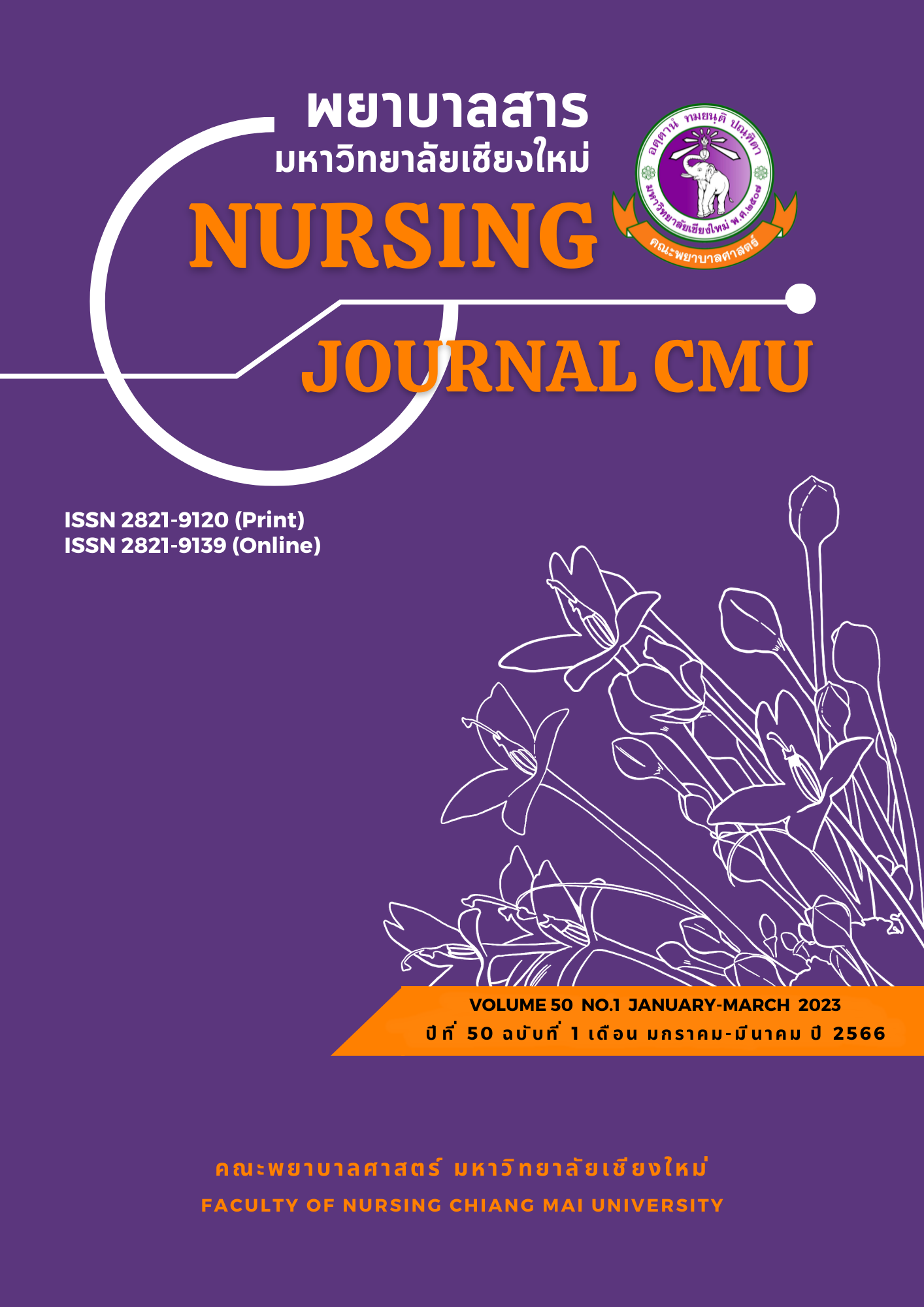การจัดการตนเองและคุณภาพชีวิตที่เกี่ยวข้องกับสุขภาพในผู้ที่เป็นโรคตับแข็ง ในเฉิงตู สาธารณรัฐประชาชนจีน
คำสำคัญ:
โรคตับแข็ง, การจัดการตนเอง, คุณภาพชีวิตที่เกี่ยวข้องกับสุขภาพบทคัดย่อ
การศึกษาครั้งนี้มีวัตถุประสงค์ เพื่อศึกษาพฤติกรรมการจัดการตนเอง และคุณภาพชีวิตที่เกี่ยวข้องกับสุขภาพของผู้ที่เป็นโรคตับแข็ง และความสัมพันธ์ระหว่างพฤติกรรมการจัดการตนเอง และคุณภาพชีวิตที่เกี่ยวข้องกับสุขภาพ ใช้วิธีการสุ่มแบบเจาะจงเพื่อเลือกกลุ่มตัวอย่างจากโรงพยาบาลในสังกัดของมหาวิทยาลัยเฉิงตู เมืองเฉิงตู มณฑลเสฉวน สาธารณรัฐประชาชนจีน จำนวน 153 ราย เครื่องมือที่ใช้ในการวิจัยประกอบด้วย แบบฟอร์มข้อมูลส่วนบุคคล แบบวัดพฤติกรรมการจัดการตนเอง และแบบวัดคุณภาพชีวิตที่เกี่ยวข้องกับสุขภาพ ค่าCronbach’s alpha coefficient ของแบบวัดพฤติกรรมการจัดการตนเอง และคุณภาพชีวิตที่เกี่ยวข้องกับสุขภาพได้เท่ากับ 0.93 และ 0.96 ตามลำดับ วิเคราะห์ข้อมูลโดยใช้สถิติเชิงพรรณนา และสถิติ Pearson product-moment coefficient และสถิติ Spearman’s rank-order correlation
ผลการศึกษาครั้งนี้พบว่า คะแนนเฉลี่ยของพฤติกรรมการจัดการตนเองและคุณภาพชีวิตที่เกี่ยวข้องกับสุขภาพโดยรวมเท่ากับ 69.58 (SD = 7.29) และ 4.95 (SD = 0.78) ตามลำดับ พฤติกรรมการจัดการตนเองมีความสัมพันธ์ทางบวกกับคุณภาพชีวิตที่เกี่ยวข้องกับสุขภาพในระดับต่ำอย่างมีนัยสำคัญทางสถิติ (r = .23, p < .01) โดยในมิติของการจัดการตนเองด้านการจัดการยามีความสัมพันธ์ทางบวกกับกับคุณภาพชีวิตที่เกี่ยวข้องกับสุขภาพในระดับปานกลางอย่างมีนัยสำคัญทางสถิติ (rs = .37, p < .01) ในขณะที่ การจัดการชีวิตประจำวันมีความสัมพันธ์ทางบวกกับคุณภาพชีวิตที่เกี่ยวข้องกับสุขภาพในระดับต่ำอย่างมีนัยสำคัญทางสถิติ (rs = .26, p < .01) อย่างไรก็ตาม มิติการจัดการเฝ้าระวังความเจ็บป่วยและการจัดการด้านอาหารไม่มีความสัมพันธ์กับคุณภาพชีวิตที่เกี่ยวข้องกับสุขภาพ
ผลของการศึกษานี้ อาจเป็นประโยชน์ต่อพยาบาลในคลินิกโดยการให้ข้อมูล เพื่อส่งเสริมพฤติกรรมการจัดการตนเองของผู้ที่เป็นโรคตับแข็งในประเทศจีน การจัดการยาและชีวิตประจำวันอาจจะช่วยส่งเสริมคุณภาพชีวิตที่เกี่ยวข้องกับสุขภาพในผู้ที่เป็นโรคตับแข็ง
References
Dong, N., Chen, W. T., Bao, M., Lu, Y., Qian, Y., & Lu, H. (2018). Self-management behaviors among patients with liver cirrhosis in Shanghai, China: A cross-sectional study. Clinical Nursing Research, 29(7), 448-459. doi: 10.1177/1054773818777914
Gao, F., Gao, R., Li, G., Shang, Z. M., & Hao, J. Y. (2013). Health-related quality of life and survival in Chinese patients with chronic liver disease. Health and Quality of Life Outcomes, 11, 131. doi: 10.1186/1477-7525-11-131
Hayward, K. L., Horsfall, L. U., Ruffin, B. J., Cottrell, W. N., Chachay, V. S., Irvine, K. M., … Valery, P. C. (2017). Optimising care of patients with chronic disease: Patient-oriented education may improve disease knowledge and self-management. Internal Medicine Journal, 47(8), 952-955. doi: 10.1111/imj.13505
Hou, J. Y. (2018). Status and influential factors of self-health management of patients with liver cirrhosis (Unpublished master’s thesis). North China University of Science and Technology, Heibei.
Kok, B., Whitlock, R., Ferguson, T., Bailey, R. J., Burak, K. W., Kowalczewski, J., & Tandon, P. (2020). Health-related quality of life: A rapid predictor of hospitalization in patients withcirrhosis. Journal of the American College of Gastroenterology, 115(4), 575-583.
Liu, Y., Sai, Z., Zhao, Y., Du, J., Jin, G., Shao, S., & Lu, X. (2016). Development and application of the Chinese (Mainland) version of chronic liver disease questionnaire to assess the health-related quality of life (HRQoL) in patients with chronic hepatitis B. PloS One, 11(9), e0162763.
Mansouri, P., Ghadami, M., Najafi, S. S., & Yektatalab, S. (2016). The effect of self-management training on self-efficacy of cirrhotic patients referring to Transplantation Center of Nemazee Hospital: A randomized controlled clinical trial. International Journal of Community Based Nursing and Midwifery, 5(3), 256-263.
Peng, J-K., Hepgul, N., Higginson, I. J., & Gao, W. (2019). Symptom prevalence and quality of life of patients with end-stage liver disease: A systematic review and meta-analysis. Palliative Medicine, 33(1), 24-36. doi: 10.1177/0269216318807051
Perumpail, B. J., Li, A. A., Cholankeril, G., Kumari, R., & Ahmed, A. (2017). Optimizing the nutritional support of adult patients in the setting of cirrhosis. Nutrients, 9(10). doi: 10.3390/nu9101114
Polit, D. F., & Beck, C. T. (2004). Nursing research: Principles and methods. Philadelphia: Lippincott Williams & Wilkins.
Poordad, F. F. (2015). Presentation and complications associated with cirrhosis of the liver. Current Medical Research and Opinion, 31(5), 925-937. doi: 10.1185/03007995.2015.1021905
Rabiee, A., Ximenes, R. O., Nikayin, S., Hickner, A., Juthani, P., Rosen, R. H., & Garcia‐Tsao, G. (2021). Factors associated with health‐related quality of life in patients with cirrhosis: A systematic review. Liver International, 41(1), 6-15.
Ren, H., Liu, C., Wang, R., Zhang, M., Tang, L., & Liu, F. (2018). Self-management behavior and its influencing factors of patients with cirrhosis: A cross-sectional survey. West China Medical Journal, 33(5), 574-578.
Sepanlou, S. G., Safiri, S., Bisignano, C., Ikuta, K. S., Merat, S., Saberifiroozi, M., … Malekzadeh, R. (2020). The global, regional, and national burden of cirrhosis by cause in 195 countries and territories, 1990-2017: A systematic analysis for the global burden of disease study 2017. The Lancet Gastroenterology & Hepatology, 5(3), 245-266. doi: 10.1016/s2468-1253(19)30349-8
Sharma, P., Gupta, C., Kumar, A., Arora, A., Anikhindi, S. A., Singla, V., & Jasrotia, S. (2021). Nutritional assessment and factors affecting dietary intake in patients with cirrhosis: A single-center observational study. Nutrition, 84, 111099.
Shetty, A., Yum, J. J., & Saab, S. (2019). The gastroenterologist's guide to preventive management of compensated cirrhosis. Gastroenterology & Hepatology, 15(8), 423-430.
Su, C. W., Yang, Y. Y., & Lin, H. C. (2018). Impact of etiological treatment on prognosis. Hepatology International, 12(Suppl. 1), 56-67. doi: 10.1007/s12072-017-9807-0
Tandon, P., & Berzigotti, A. (2020). Management of lifestyle factors in individuals with cirrhosis: A pragmatic review. In Seminars in Liver Disease (Vol. 40, No. 01, pp. 020-028).Thieme Medical Publishers.
Volk, M. L., Fisher, N., & Fontana, R. J. (2013). Patient knowledge about disease self-management in cirrhosis. American Journal of Gastroenterology, 108(3), 302-305. doi: 10.1038/ajg.2012.214
Wang, W. L. (2012). Regional differences in Chinese food culture. Geography teaching, (18), 6-8.
Wang, Q., Wang, Y., Gao, J., Han, J., & Li, Y. (2015). Development of a self-management behaviour scale for LC. International Journal of Nursing Sciences, 2(1), 73-79. doi: 10.1016/j.ijnss.2014.10.015
Xiao, J., Wang, F., Wong, N., He, J., Zhang, R., Sun, R., … Li, C. (2019). Global liver disease burdens and research trends: Analysis from a Chinese perspective. Journal of Hepatology, 71(1), 212-221. doi: 10.1016/j.jhep.2019.03.004
Younossi, Z. M., Guyatt, G., Kiwi, M., Boparai, N., & King, D. (1999). Development of a disease specific questionnaire to measure health related quality of life in patients with chronic liver disease. Gut, 45(2), 295-300. doi: 10.1136/gut.45.2.295
Zhang, N., & Ma, G. (2020). Nutritional characteristics and health effects of regional cuisines in China. Journal of Ethnic Foods, 7(1). doi: 10.1186/s42779-020-0045-z
Zhang, X., Xi, W., Liu, L., & Wang, L. (2019). Improvement in quality of life and activities of daily living in patients with liver cirrhosis with the use of health education and patient health empowerment. Medical Science Monitor, 25, 4602-4608. doi:10.12659/MSM.914487
Downloads
เผยแพร่แล้ว
How to Cite
ฉบับ
บท
License
Copyright (c) 2023 พยาบาลสาร

This work is licensed under a Creative Commons Attribution-NonCommercial-NoDerivatives 4.0 International License.
บทความที่ได้รับการตีพิมพ์เป็นลิขสิทธิ์ของวารสารพยาบาลสาร
ข้อความที่ปรากฏในบทความแต่ละเรื่องในวารสารวิชาการเล่มนี้เป็นความคิดเห็นส่วนตัวของผู้เขียนแต่ละท่านไม่เกี่ยวข้องกับมหาวิทยาลัยเชียงใหม่ และคณาจารย์ท่านอื่นๆในมหาวิทยาลัยฯ แต่อย่างใด ความรับผิดชอบองค์ประกอบทั้งหมดของบทความแต่ละเรื่องเป็นของผู้เขียนแต่ละท่าน หากมีความผิดพลาดใด ๆ ผู้เขียนแต่ละท่านจะรับผิดชอบบทความของตนเองแต่ผู้เดียว





